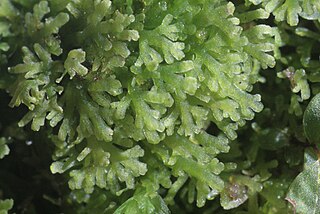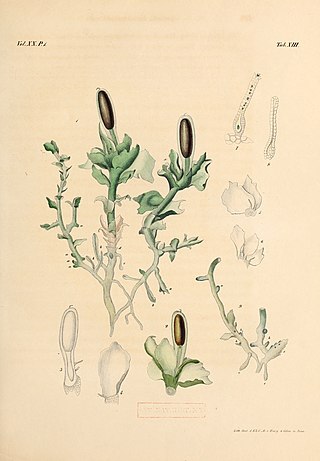
Jungermanniales is the largest order of liverworts. They are distinctive among the liverworts for having thin leaf-like flaps on either side of the stem. Most other liverworts are thalloid, with no leaves. Due to their dorsiventral organization and scale-like, overlapping leaves, the Jungermanniales are sometimes called "scale-mosses".

Metzgeriales is an order of liverworts. The group is sometimes called the simple thalloid liverworts: "thalloid" because the members lack structures resembling stems or leaves, and "simple" because their tissues are thin and relatively undifferentiated. All species in the order have a small gametophyte stage and a smaller, relatively short-lived, spore-bearing stage. Although these plants are almost entirely restricted to regions with high humidity or readily available moisture, the group as a whole is widely distributed, and occurs on every continent except Antarctica.

Jungermanniopsida is the largest of three classes within the division Marchantiophyta (liverworts).

Lepidoziaceae is a family of leafy liverworts. It is a group of small plants that are widely distributed.
Folioceros is a genus of hornworts in the family Anthocerotaceae. The genus is common locally in the tropical and subtropical regions of Asia, growing on moist rocks, in fallow fields, and near waterfalls. It has a yellow-green gametophyte thallus that is crispy and translucent, with short branchings that are almost pinnate. Plants are usually less than a centimeter wide and 3 centimeters long. They may be monoicous or dioicous.

Pallaviciniaceae is a widely distributed family of liverworts in the order Pallaviciniales. All species are thallose, typically organized as a thick central costa (midvein), each side with a broad wing of tissue one cell in thickness. All species are dioicous. The greatest diversity is in Australasia, with some species endemic to that region, though species belonging to the family may be found on every continent except Antarctica.
Leptoscyphus is a genus of liverwort in family Lophocoleaceae.

Herbertaceae is a family of liverworts. The family consists of the genera Herbertus, Schisma and Triandrophyllum. The genus HerpocladiumMitten, 1873 was later merged into the genus Herbertus.

Hymenophyton is a genus of the order Pallaviciniales (liverworts) containing one to three species. The genus was formerly described as monotypic, as each member possesses a close morphological resemblance, but phytochemical and molecular evidence now supports an infrageneric classification two separate species. The name Hymenophyton leptopodum, regarded as a synonym of Hymenophyton flabellatum, has been resurrected. A population found in Chile is regarded as a separate clade, and the reinstatement of Hymenophyton pedicellatum has been proposed.
Theodor Carl (Karl) Julius Herzog was a German bryologist and phytogeographer. This botanist is denoted by the author abbreviation Herz. when citing a botanical name.

Pleurozia is the only genus of liverworts in the family Pleuroziaceae, which is now classified in its own order Pleuroziales, but was previously included in a broader circumscription of the Jungermanniales. The genus includes twelve species, and as a whole is both physically distinctive and widely distributed.
Vetaforma is a genus of liverworts found only in Argentina and Chile, and contains a single species Vetaforma dusenii. It is classified in order Jungermanniales and is the only member of the family Vetaformataceae within that order. The genus and family names were originally published in 1960, but this publication was invalid under Article 36.1 of the ICBN.

Cephaloziaceae is a family of liverworts.

Leiomitra is a genus of liverworts in the family Trichocoleaceae.

Haplomitrium is a genus of liverwort.

Pallaviciniales is an order of liverworts.
Isophyllaria is a genus of liverworts belonging to the family Pseudolepicoleaceae.
Herzogiaria is a genus of liverworts belonging to the family Pseudolepicoleaceae.
Lepicoleaceae is a family of liverworts belonging to the order Jungermanniales.
Pseudolepicolea is a genus of liverworts belonging to the family Pseudolepicoleaceae.











